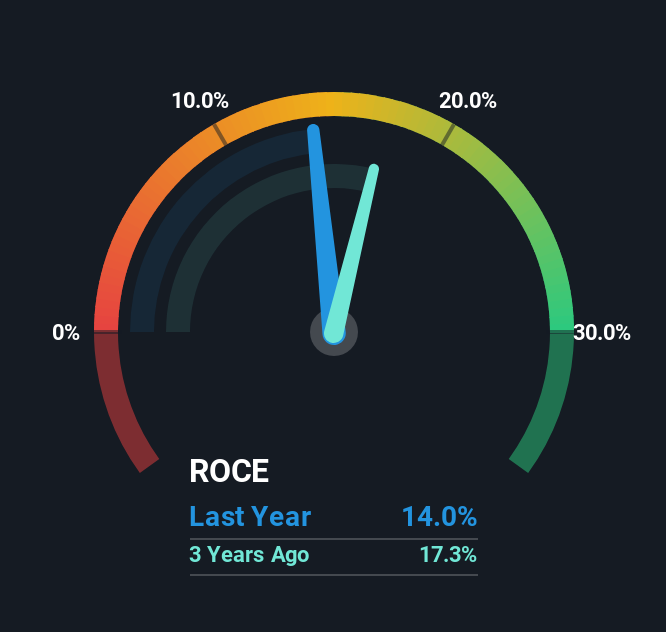Returns On Capital At Universal Display (NASDAQ:OLED) Have Stalled
Finding a business that has the potential to grow substantially is not easy, but it is possible if we look at a few key financial metrics. Ideally, a business will show two trends; firstly a growing return on capital employed (ROCE) and secondly, an increasing amount of capital employed. Basically this means that a company has profitable initiatives that it can continue to reinvest in, which is a trait of a compounding machine. That's why when we briefly looked at Universal Display's (NASDAQ:OLED) ROCE trend, we were pretty happy with what we saw.
Understanding Return On Capital Employed (ROCE)
Just to clarify if you're unsure, ROCE is a metric for evaluating how much pre-tax income (in percentage terms) a company earns on the capital invested in its business. Analysts use this formula to calculate it for Universal Display:
Return on Capital Employed = Earnings Before Interest and Tax (EBIT) ÷ (Total Assets - Current Liabilities)
0.14 = US$246m ÷ (US$1.9b - US$113m) (Based on the trailing twelve months to March 2025).
So, Universal Display has an ROCE of 14%. In absolute terms, that's a satisfactory return, but compared to the Semiconductor industry average of 8.9% it's much better.
View our latest analysis for Universal Display

Above you can see how the current ROCE for Universal Display compares to its prior returns on capital, but there's only so much you can tell from the past. If you'd like, you can check out the forecasts from the analysts covering Universal Display for free.
The Trend Of ROCE
While the returns on capital are good, they haven't moved much. Over the past five years, ROCE has remained relatively flat at around 14% and the business has deployed 75% more capital into its operations. 14% is a pretty standard return, and it provides some comfort knowing that Universal Display has consistently earned this amount. Stable returns in this ballpark can be unexciting, but if they can be maintained over the long run, they often provide nice rewards to shareholders.
The Bottom Line
The main thing to remember is that Universal Display has proven its ability to continually reinvest at respectable rates of return. In light of this, the stock has only gained 10% over the last five years for shareholders who have owned the stock in this period. So to determine if Universal Display is a multi-bagger going forward, we'd suggest digging deeper into the company's other fundamentals.
While Universal Display doesn't shine too bright in this respect, it's still worth seeing if the company is trading at attractive prices. You can find that out with our FREE intrinsic value estimation for OLED on our platform.
For those who like to invest in solid companies, check out this free list of companies with solid balance sheets and high returns on equity.
Have feedback on this article? Concerned about the content? Get in touch with us directly. Alternatively, email editorial-team (at) simplywallst.com.
This article by Simply Wall St is general in nature. We provide commentary based on historical data and analyst forecasts only using an unbiased methodology and our articles are not intended to be financial advice. It does not constitute a recommendation to buy or sell any stock, and does not take account of your objectives, or your financial situation. We aim to bring you long-term focused analysis driven by fundamental data. Note that our analysis may not factor in the latest price-sensitive company announcements or qualitative material. Simply Wall St has no position in any stocks mentioned.
 Wall Street Journal
Wall Street Journal